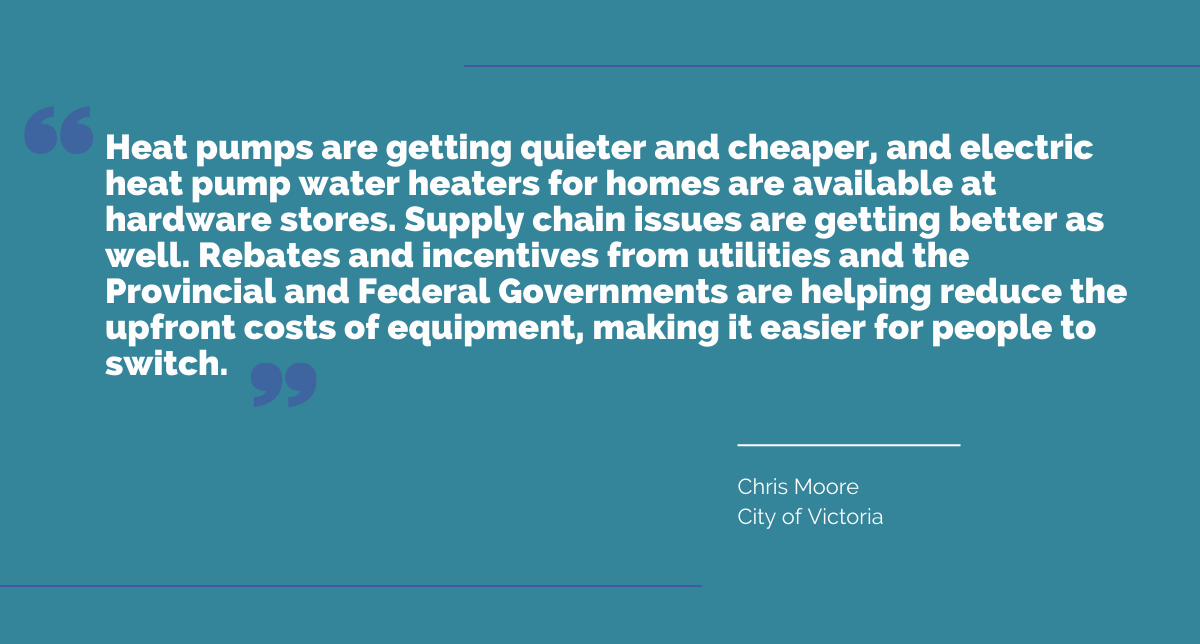
In the next installment of our Member Spotlight series, meet some of the Climate Action Team at the City of Victoria. With a population of 94,000 and over 4 million visitors annually, Victoria is home to a dynamic, thriving economy and vibrant arts and culture scene, with an unparalleled natural environment enjoyed by all. We hear from John Ho, Derek de Candole and Chris Moore whose combined efforts are driving climate action and electrification initiatives in their community. Their dedication and innovative approaches exemplify the commitment of local government to making a significant impact on our environment and community.
Tell us about your team and the role you play within the organization
Derek: The Climate Action Team at the City of Victoria has a core group of six members with three more active team members who are also a part of other divisions. Having positions that act as functional members of multiple teams increases the opportunities for collaboration, leveraging work from across the organization to further all City objectives, including progress on climate action targets. The Extended Climate Action Team has staff focused on grant writing for the whole organization, a Corporate Energy Specialist who focuses on emissions reductions for City-owned assets, two positions focused on community and corporate Electric Vehicle adoption including both policy development and project delivery, one position focused on adaptation, and three positions dedicated to reducing emissions from new and existing buildings. The extended climate action team develops programs, policies and regulations and provides project management to implement the City’s Climate Leadership Plan, with the aim of reducing community-wide emissions and adapting to the changing climate.
Why did you become a B2E member?
John: We became a B2E member to join a diverse community of leaders who have the common goal of accelerating electrification in buildings. Not only is electrification integral to meeting our climate targets, but it also carries the promise of providing many other benefits to building owners and building occupants. There are many barriers to electrification and having a platform to learn from peers and experts from other disciplines, who can speak to various perspectives, is invaluable when considering new policies and initiatives. As a local government that is continually seeking to find innovative ways to advance electrification initiatives and be leaders in the space, we also recognize how we can add value by helping others reach their targets by sharing what we have implemented and learned.
What impact has the B2E community had on you/your organization?
John: From a personal perspective, B2E has deeply contributed to my knowledge and understanding of the many facets of electrification, as well as professional development through being given the opportunity to chair the Awareness Building and Communications subcommittee. Being a part of the ABC (and other) sub-committees also allows us to stay up to date on all the cutting-edge work that others are doing. Additionally, it opens the door to exciting collaboration opportunities where we have been able to work on new B2E-funded projects that fill gaps which we can then take back to our community. At a high level, the B2E community has helped us to better communicate the importance of electrification and position it as the key climate solution for buildings. We are at a critical juncture when it comes to meeting our climate targets, and being a part of B2E will help get us there faster!
Tell us about the recent adoption of the Zero Carbon Step Code. Please highlight any parts of your work that has changed as a result
Derek: The City of Victoria, District of Saanich, District of Central Saanich and Capital Regional District worked closely together from December 2021 through April 2023 to develop the policy and bylaw amendments necessary to adopt the Zero Carbon Step Code (ZCSC). The policy development included an extensive three phase regional engagement and technical review of permitting data and reports on low carbon buildings in BC. Beyond the collaboration of the involved local and regional governments, we also collaborated with the local industry to plan out the engagement, ensuring there were enough varied opportunities for engagement to ensure that anyone involved in construction in the Greater Victoria Area who wanted to, was able to participate. The adoption of the ZCSC has capped the emissions of most new construction in Victoria and Saanich, with most buildings being required to meet Emissions Level 4, known as Zero Carbon by the end of 2024.
This has had a big impact on how the City of Victoria is working with industry on new construction. Rather than focusing on policy and information and education campaigns to reduce operating emissions, staff have begun to be able to focus on ensuring the regulatory requirements are clear, and developing case studies providing examples of how the standard has been met in existing projects. It has also allowed our longer term focus to shift towards operating emissions from existing buildings and embodied carbon in new construction.
What do you see as a key driver in advancing electrification in the municipality?
Chris: Even before the Zero Carbon Step Code, we were seeing an increasing trend in electric systems in buildings here in Victoria. A lot of folks are seeing the value in the co-benefits from the systems like lower operating costs and having air conditioning during the summer with a heat pump. Locally, there are more new, improved, and increasingly available technologies that are offering better performance for lower cost.

Heating and cooling homes with renewable energy really align with the community values of Victorians, so as the process gets easier and cost barriers are reduced, more and more people want electrified buildings.
Still, the key barriers are the complexity and cost of retrofitting existing buildings. That's why the City of Victoria and others are creating ways to help smooth the process for building owners. We're launching a tax incentive pilot to kickstart energy retrofits in existing rental buildings. We supported the Capital Regional District's great work in launching the Home Energy Navigator program that helps guide homeowners through a retrofit process and connect them with grant and incentive funding. We're also developing a similar concierge program for strata condominium buildings and hope to explore more options in the future.
Do you have any advice for others (individuals or organizations) who want to follow your path?
Chris: Electrification is doable, but it's not necessarily a simple process. Find ways to help reduce that time and effort for people (or organizations) to get the ball rolling on project planning and funding applications. Even things on a small scale like info or FAQ documents, guidance for grant applications, or lists of local installation companies can make a difference.
When considering adopting Zero Carbon Step Code requirements, go out and talk with builders, building designers, and engineers about their thoughts. You may be surprised to find that, like here, industry is prepared to build all electric buildings and are likely already doing so. It may not be such a big leap in regulation as one might initially think.
Furthermore, electrification at a large scale is going to need a lot of skilled and dedicated workers. Support industry groups and encourage young people to consider trades related to buildings and energy. A career in trades is a career in climate action!
With thanks to:

 b2e@zeic.ca
b2e@zeic.ca


